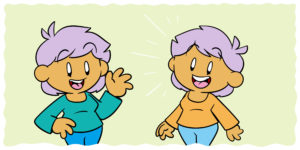One of the biggest hurdles when improving a story is moving past its original form. While authors instinctively set to work improving character, dialogue, description, action, and voice, most consider the first plot structure they set down on the page to be the definitive version. As a consequence, important elements of a story are improved, but they all remain married to the most basic version of its plot. Getting past this problem takes work, but it can start with a simple question: ‘Do I really need to start at the beginning?’
Beginning, middle, end
When we’re at school, teachers tell us that a story has a beginning, a middle, and an end. It’s a good way to begin understanding story structure, but it isn’t necessarily true. Plenty of stories conclude on a meaningful cliffhanger; Thomas Pynchon’s The Crying of Lot 49 ends right before the protagonist finds out the identity of a mysterious auction bidder, while Joel and Ethan Coen’s A Serious Man ends on a note of such deliberate incompleteness that it can feel like a taunt. Likewise, there are plenty of stories, like Emily Brontë’s Wuthering Heights, that use clever tricks to skip uneventful middles, and some, like Garth Ennis’ Battlefields, that assume a setting like WWII brings enough knowledge with it to make a ‘beginning’ pointless.
Does every story have a beginning, a middle, and an end? No, not exactly.Click To TweetThat’s not to say that these stories don’t have an arc, that they don’t begin with a concept, but the idea that this has to be represented in literal structure is often counterproductive. Instead, a better story model might be ‘status quo, conflict, resolution’, and even then, not necessarily in chronological order.
Status quo, conflict, resolution
The terms above are far less absolute than they first appear. The Crying of Lot 49 is about, ultimately, a mystery that isn’t worth solving. Its protagonist is forced to attend to an old acquaintance’s affairs, discovering a mystery that alienates her from her comfortable life and then fosters that alienation, making the world feel strange and pointless. The mystery unspools and the reader gets a surprising amount of answers, but it doesn’t ‘end’; indeed, the book finishes by ruminating on how meaningless that end would be. Pynchon does resolve the story he’s telling; it’s a story about alienation and confusion, and by revealing the hollowness of the mystery he’s created, he takes a comfortable status quo, breaks it, and then resolves that situation. In the case of The Crying of Lot 49, that resolution is grim discomfort, but it is a resolution.
At the same time, the reality of a status quo is more flexible than one might expect. The initial status quo of a story is the existing state of affairs, often presented as a comfortable stasis which is then disrupted by conflict. It’s the peace before the war, the dinner party before the murder, and the marriage before the affair. The important part of the status quo is not that it’s pleasant (often its unpleasantness spurs the action) but that it’s sustained. It’s the backdrop of normality that makes the adventure of the story a noteworthy event, there to give context to the conflict (to show what’s wrong) and to offer hope for a positive resolution (there was a stable status quo once, after all).
Still, that doesn’t mean it has to be shown. In Garth Ennis’ Battlefields and War Stories, the writer hops around time and place, telling tales from various wars that explore the lives and fates of soldiers on different sides. They’re stories about humanity faced with the hell of war, but Ennis rarely shows a character comfortable at home, called to battle, and then fighting. Instead, he skips to that final moment and either uses the character’s reminiscences, the implication of the setting, or even just the assumptions of the reader to suggest a peacetime that’s never shown. In doing so, he tells incredibly dynamic stories that are still satisfying in terms of structure.
A story’s status quo is important, but it can be established in retrospect.Click To TweetIn such stories, the ‘beginning’ is pointless – the reader doesn’t need it – and even the status quo it represents can be introduced at the time of the author’s choosing. It’s a method that can improve a story, and especially its opening, but it depends on understanding what your story is about.
Setting and story
I said earlier that status quo is important because it contextualizes the story as an adventure, so let’s imagine two stories. Both are about a character caught up in a chaotic battle. In the first, the battle is part of a war that’s been going on for generations. The protagonist has no idea what peace would look like, and while the battle is a necessary part of life, it’s not going to end the war.
In the second version of the story, the war has been going on for the character’s whole life, but her parents have instilled in her a mythic idea of what peace can look like, and while the battle won’t end the war, she thinks it will bring her closer to that.
The second version of this story is the better one, because that’s the story that lends any meaning to its conflict. In fact, the first story doesn’t have any real conflict – if war is the status quo of your setting, then why would further war represent any kind of change?
Despite this, we can make the first story have meaning. All you’d have to do is set up another struggle within it; maybe it’s the story of whether the character in question survives, for example, or whether she can find joy in a tumultuous world. By doing this, we’re actually telling a different story, one that has its own status quo, conflict, and resolution. The character is alive, a situation arrives that might kill her, she lives/dies. The character is unhappy, a situation arrives that might change that, it does/doesn’t.
In this way, we can see how what your story is ‘about’ can define where it begins and what the reader needs to see. As in Ennis’ war stories, there’s often no need to see the start of a war, even the start of a battle, if the actual story you’re telling is within that situation. Similarly, if your conflict is clear enough, you can bring the theoretical status quo in later; indeed, if the status quo is familiar enough to the reader, like just not being injured, you can do it purely by implication.
Examine your story and ask what it’s actually about, then assess whether you’ve begun earlier than you need to. This is the advice that makes that old chestnut ‘start with the action’ more possible, since it makes it clear what you can brush away, but that’s not the only advantage.
Advantages of arriving late
A fancier way of saying to ‘start with the action’ is to suggest a story should begin in media res. That is, in the middle of things, with the story already underway. Since we covered the advantages of this in “Start With The Action!” – What It Means And When You Should Do It, I won’t overdo it here, but suffice to say that beginning with your conflict can be an incredibly involving way to begin a story. It grabs the reader, it hooks their interest, and it doesn’t waste their time before getting to the good bit.
That, however, is only the simplest benefit of not starting at the beginning. Earlier, I talked about plot structure, and how many authors can benefit from asking ‘do I really need to start at the beginning?’ That’s a good question when it’s about the plot as a whole – when it’s akin to ‘should the reader arrive later?’ – but it’s a great question when it relates to characters.
Often, the most interesting version of your plot won’t be the one you first thought of. That version was necessary to get everything in order, but it can be improved. In a traditional murder mystery, for example, it can be more interesting for the protagonist to arrive after the murder, discovering backstory in the more exciting context of a dead body rather than chapters’ worth of vaguely suspicious people getting ready for a normal evening. This technique – leading with the exciting event that actually grips the reader – can give the story immediate energy. Would you rather read a book that begins with an ordinary man and then renders him a convict on the run halfway through, or a book that starts with a convict on the run and then spends its length alternately explaining how that came to be and how it ends?
Does your story start in the most interesting place? If not, why not?Click To TweetMany books begin by skipping ahead to their eventual consequences, revealing just enough to make the mundane events that ‘begin’ the story feel tense and vital. J.G. Ballard’s High-Rise is famous for this trick; by the tenth word of the opening line, the reader is gripped.
Later, as he sat on his balcony eating the dog, Dr Robert Laing reflected on the unusual events that had taken place within this huge apartment building during the previous three months. Now that everything had returned to normal, he was surprised that there had been no obvious beginning, no point beyond which their lives had moved into a clearly more sinister dimension.
– J.G. Ballard, High-Rise
Now, not only is the reader excited to see what happened during those three months, but Ballard gets to depict a gradual descent without worrying about a boring opening. This can be taken even further, as in Chuck Palahniuk’s Fight Club, to not just get the reader interested in what’s going to happen, but to influence how they’ll feel about it as it does.
Tyler gets me a job as a waiter, after that Tyler’s pushing a gun in my mouth and saying, the first step to eternal life is you have to die. For a long time though, Tyler and I were best friends. People are always asking, did I know about Tyler Durden.
The barrel of the gun pressed against the back of my throat, Tyler says, “We really won’t die.”
– Chuck Palahniuk, Fight Club
Here, Palahniuk skips ahead to prime the reader’s expectations about how the narrator’s relationship with Tyler will develop, changing how they’ll feel about the story as it unfolds.
Other books are even more experimental with structure and chronology. Kurt Vonnegut’s Galapagos looks back on tumultuous events from a future of immense peace, its narrator even noting who will die soon, sometimes explaining their eventual fates even as they fight for their lives (a trick that also appears in Jennifer Egan’s A Visit From the Goon Squad). The result is a comment on human nature; the fervor with which we approach the immediate moment and how that might look to someone who knows better.
Martin Amis’ Time’s Arrow is predicated on not starting at the beginning, telling the story of a Nazi war criminal’s life in reverse, so that, as the blurb says, ‘He dies and then feels markedly better, breaks up with his lovers as a prelude to seducing them and mangles his patients before he sends them home.’
Applying unusual plot structure to your work
All of the above is not to say that any of these devices are the perfect form of storytelling, but they all improve the stories in which they’re used, and they were all arrived at by authors who looked at traditional story structure, the order in which plot events were presented, and asked, ‘is this the best form of my story?’
Don’t commit to the first plot structure that comes along.Click To TweetWhile you may know your story by its current structure, don’t be too quick to label that the definitive version. Where do the events that your story’s really about begin, and would the story as a whole benefit from being able to ration that information or else influence how it’s read by starting at a different point? Where does your protagonist come into events and why? If it’s just out of necessity, so they can see everything that matters, remember that there are always other options. The literal protagonist of Wuthering Heights arrives in the middle of the story, finding out what happened before he arrived out of sheer nosiness, and it provides Brontë with the opportunity to mix middle with beginning and tell her story through a host of unreliable narrators. It’s a twist in the tale that’s part of why that particular story is so beloved, and if you’re open to experimentation, a similar twist might transform your own work for the better.
If this article has you questioning where to start, check out Why Writers Like You Need To Know Their Key Event From Their First Plot Point and What Everybody Ought To Know About Writing A First Chapter for more great advice. Or, if you’ve already been experimenting, let me know the results in the comments below. Where does your story start, and why was that your choice?





